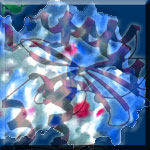|
One-component systems are usually combined into protein families according to sequence similarity. Global genome sequencing efforts have revealed a large number of potential regulatory proteins that were assigned by sequence similarity to the families of the LysR (3745 ORFs), IclR (522 ORFs), and GntR (1943 ORFs) transcriptional regulators. The few representatives of these families that have been experimentally characterized have distinguishable DNA-binding and effector binding domains. While the DNA binding domain (usually helix-turn-helix motif) can be identified by sequence analysis and modeled with a high level of confidence for the majority of these families members, the ligand specificity of their effector binding domains (EBD) and their structures cannot be predicted on the basis of sequence similarity and must be determined experimentally. Moreover, little is known about the molecular mechanisms of ligand binding and its action on the regulator activity.
In our work, we focus on structural and functional characterization of “orphan” bacterial regulators and their effector binding domains. We cloned and purified over 50 potential transcriptional regulators and their EBDs from Escherichia coli, Pseudomonas aeruginosa, and Thermotoga maritima. The structures of six different IclR regulators and one GntR regulator have been determined so far. The purified regulators were also screened for binding against the library of 140 representatives of different classes of cellular metabolites. We identified several potential effectors and characterized their effect on the activity of the corresponding regulators.
|

|